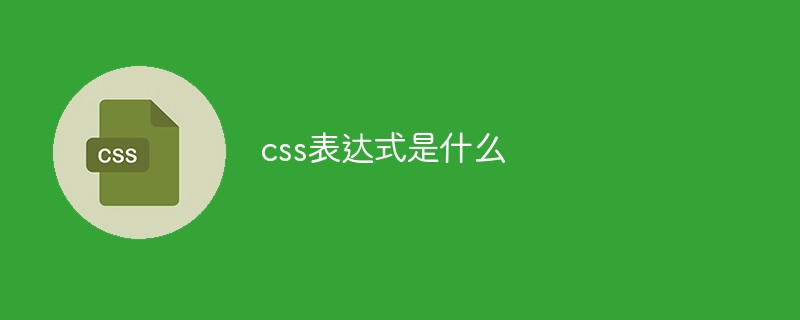
css expression is to use expression() after the css attribute to connect a JavaScript expression. The value of the css attribute is the result of the JavaScript expression; the syntax format is "css attribute: expression (JavaScript expression);".

The operating environment of this tutorial: Windows 7 system, CSS3&&javascript version 1.8.5, Dell G3 computer.
IE5 and later versions support the use of expression in CSS to associate CSS properties with Javascript scripts. The CSS properties here can be inherent properties of the element or custom properties.
css expression is to use expression() after the css attribute to connect a JavaScript expression. The value of the css attribute is the result of the JavaScript expression.
You can directly reference the properties and methods of the element itself in the expression, or you can use other browser objects. The expression appears as if it were inside a member function of this element.
Do you feel that the above text is a bit obscure? It doesn't matter, you just need to know: we can write Javascript scripts in css files through expression, and use it to achieve some very convenient functions and effects.
Expression application:
1. Assign a value to the element’s inherent attribute. The following example is to position an element according to the size of the browser.
<!DOCTYPE html PUBLIC "-//W3C//DTD XHTML 1.0 Strict//EN" "http://www.w3.org/TR/xhtml1/DTD/xhtml1-strict.dtd">
<html xmlns="http://www.w3.org/1999/xhtml">
<head>
<meta http-equiv="Content-Type" content="text/html; charset=utf-8" />
<title>mid.lt263.com/mb</title>
<style type="text/css">
#myDiv {
position: absolute;
width: 100px;
height: 100px;
background:#c00;
left: expression(document.body.offsetWidth - 180 "px");
top: expression(document.body.offsetHeight - -80 "px");
text-align:center;
line-height:90px;
color:#fff;
}
</style>
</head>
<body>
<div id="myDiv">mb5u.com</div>
</body>
</html>2. Assign a value to the element’s custom attribute
Let’s look at the following example:
<!DOCTYPE html PUBLIC "-//W3C//DTD XHTML 1.0 Strict//EN" "http://www.w3.org/TR/xhtml1/DTD/xhtml1-strict.dtd">
<html xmlns="http://www.w3.org/1999/xhtml">
<head>
<meta http-equiv="Content-Type" content="text/html; charset=utf-8" />
<title>mid.lt263.com/mb</title>
<style type="text/css">
a {star:expression(this.onFocus=this.blur())}
</style>
</head>
<body>
<a href="#" _fcksavedurl="#">模板天下 - mid.lt263.com/mb
</p>
</body>
</html>Description: The star inside is an attribute defined arbitrarily by you. You can customize it as you wish. Preferences are defined separately, and then the statement contained in expression() is the JS script. Don’t forget there is a quotation mark between the custom attribute and expression. Because the essence is still CSS, it is placed in the style tag instead of the script. . In this way, it is easy to eliminate the link dotted box in the page in one sentence. What needs your special attention: Unless there is a very special need to use expression, it is generally not recommended to use expression, because expression requires relatively high browser resources.
Note:
CSS expressions are a powerful (but dangerous) way to dynamically set CSS properties. Internet Explorer supports CSS expressions starting with version 5. In the following example, a CSS expression can be used to switch the background color every hour:
background-color: expression( (new Date()).getHours()%2 ? "#B8D4FF" : "#F08A00" );
As shown above, a JavaScript expression is used in expression. CSS properties are set based on the evaluation of JavaScript expressions. The expression method does not work in other browsers, so it is useful to set it up specifically for Internet Explorer in a cross-browser design.
The problem with expressions is that they are evaluated more often than we think. Not only when the page is displayed and zoomed, but also when the page is scrolled and even when the mouse is moved, it will be recalculated. Add a counter to a CSS expression to track how often the expression is evaluated. You can easily achieve more than 10,000 calculations by simply moving the mouse on the page.
One way to reduce the number of times a CSS expression is evaluated is to use a one-time expression, which assigns the result to a specified style attribute the first time it is run, and uses this attribute to replace the CSS expression. If style properties must change dynamically during page cycles, using event handlers instead of CSS expressions is a viable option. If you must use CSS expressions, be sure to remember that they are evaluated thousands of times and may have an impact on the performance of your page.
(Learning video sharing: css video tutorial)
The above is the detailed content of what is css expression. For more information, please follow other related articles on the PHP Chinese website!